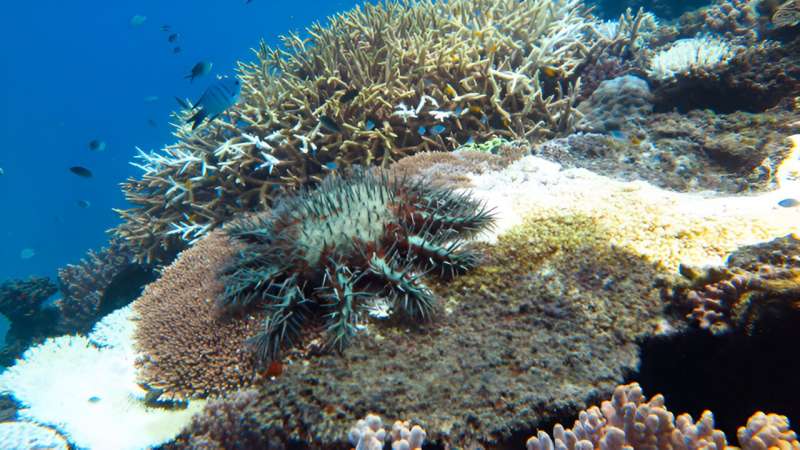This article has been reviewed according to Science X's editorial process and policies. Editors have highlighted the following attributes while ensuring the content's credibility:
fact-checked
peer-reviewed publication
proofread
New insights into juvenile crown-of-thorns starfish behaviors that threaten reefs

A new study by researchers from the University of Sydney provides new insights into the behavior of juvenile crown-of-thorns starfish (COTS), a significant contributor to coral reef devastation in the Indo-Pacific region. The research, published in Proceedings of the Royal Society B: Biological Sciences, explores how chemical cues from their environment influence their movement and dietary transition to become coral eaters.
In an innovative series of experiments conducted in flow-through choice chambers at the Sydney Institute of Marine Science, researchers observed herbivorous-stage juvenile COTS as they responded to various chemical signals from their surroundings. These juveniles, poised at a crucial dietary transition phase, were exposed to cues from their nursery habitat, comprising coral rubble covered with crustose coralline algae (CCA), as well as signals from live coral and adult COTS.
The study found that juveniles are drawn toward CCA and live coral cues, showing a distinct preference for coral when both cues are presented simultaneously. Notably, the juveniles exhibited avoidance behaviors in response to chemical cues emitted by adult COTS. This avoidance suggests a complex feedback mechanism, where the presence of adults may deter younger COTS from switching to a coral diet, potentially regulating the timing of outbreaks.
"COTS is a boom-and-bust species with features that promote this lifestyle. They are super fecund, spawning millions of eggs, the larvae can clone and very young juveniles can pause their growth as they remain camouflaged in the reef. The possibility of a density dependent transition to adulthood is likely to be key to their success," said lead author and University of Sydney Ph.D. candidate, Monique Webb.
These findings highlight the role of intraspecific and habitat-mediated interactions in shaping marine populations and underscore the importance of understanding semiochemical communication in managing the threats posed by COTS to coral reefs.
"This work points to the importance of density dependent ecology for sea stars where decrease in adult numbers as occurs through COTS culling may release juveniles from competition thereby promoting their emergence as coral predators," said Professor Maria Byrne FAA, echinoderm world expert and recipient of a Doctor of Science at the University of Galway.
The accumulation of juveniles within the reef, influenced by adult chemical cues, represents a critical but underappreciated factor in the dynamics of COTS outbreaks. Addressing this could be key to developing more effective strategies for preserving vulnerable coral ecosystems.
More information: Chemosensory behaviour of juvenile crown-of-thorns sea stars (Acanthaster sp.), attraction to algal and coral food and avoidance of adult conspecifics, Proceedings of the Royal Society B: Biological Sciences (2024). DOI: 10.1098/rspb.2024.0623. royalsocietypublishing.org/doi … .1098/rspb.2024.0623
Journal information: Proceedings of the Royal Society B
Provided by Sydney Institute of Marine Science




















